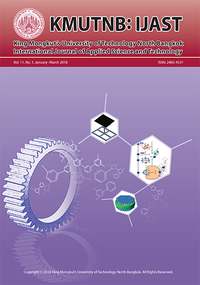Vertical Variation of Nitrogen Oxide (NOx) Concentration Using a Backward Air Mass Trajectories Model in an Urban Area of Bangkok, Thailand
Main Article Content
Abstract
Bangkok Metropolitan is a rapidly growing city with both industrial and urban area expansion resulting in the generation of a significant air pollutant; Nitrogen Oxide (NOx = NO + NO2). This research studied the variation of Nitrogen Oxide concentration in an urban area at 30 m and 110 m above ground by applying the HYSPLIT model to simulate the backward trajectories movement of air mass using the past 3 days of data from an air quality and microclimate monitoring station at Kasetsart University, Bangkok from January 2016 to February 2017. The results showed that the concentration of Nitrogen Oxide at 30 m above ground is higher than the concentration at 110 m above ground. The concentration trended to increase in winter (October 2016 to February 2017). According to the backward trajectories modeling, the major direction of air mass movement at 30 m above ground, category 1 (N-NE) and category 2 (NE-E), occupying 86% of total movement direction (concentration of NOx ranged from 4.02 to 96.35 ppb) meanwhile the major direction of air mass movement at 110 m above ground, category 1 (N-NE) and category 2 (NE-E), occupying 79% of total movement direction (concentration of NOx ranged from 3.93 to 51.50 ppb). The air mass moved through the different land use types, human activities and industrial areas. This study can be applied as a guideline for microclimate surveillance and monitoring of NOx concentration influenced by air mass movement.
Article Details
References
[2] M. J. H. Rodríguez, E. P. Melián, O. G. Díaz, J. Araña, M. Macías, A. G. Orive, and J. M. D. Rodríguez, “Comparison of supported TiO2 catalysts in the photocatalytic degradation of NOx,” Journal of Molecular Catalysis A: Chemical, vol. 413, pp. 56–66, Mar. 2016.
[3] P. Baylon, D. A. Jaffe, N. L. Wigder, H. Gao, and J. Hee, “Ozone enhancement in western US wildfire plumes at the Mt. Bachelor Observatory: The role of NOx,” Atmospheric Environment, vol. 109, pp. 297–304, May 2015.
[4] T. J. Butler, G. E. Likens, F. M. Vermeylen, and B. J.B. Stunder, “The relation between NOx emissions and precipitation NO3− in the eastern USA,” Atmospheric Environment, vol. 37, no. 15, pp. 2093–2104. 2003.
[5] S. Boonpitak and P. Pojjanat, “Study of air mass backward trajectories for investigate couse of air pollutant concentration changing in Chaina case study: Ozane,” Public Health, vol. 46, no. 2, pp. 203–215, 2016.
[6] Y. Zhou, S. Soula, V. Pont, and X. Qie, “NOx ground concentration at a station at high altitude in relation to cloud-to-ground lightning flashes,” Atmospheric Research, vol. 75, no. 1–2, pp. 47–69, 2005.
[7] Traffic and Transport Department. (2015). Traffic statistics in 2015. Bangkok Metropolitan Administration, Thailand [Online]. Available: http://office.bangkok.go.th/dotat/TrafficINFO/ StatBook/2558/thai/Statthai2558.pdf.
[8] K. H. Kim, S.-B. Lee, S. H. Woo, and G.-N. Bae, “NOx profile around a signalized intersection of busy roadway,” Atmospheric Environment, vol. 97, pp. 144–154, Nov. 2014.
[9] Q. Lu, J. Zheng, S. Ye, X. Shen, Z. Yuan, and S. Yin, “Emission trends and source characteristics of SO2, NOx, PM10 and VOCs in the Pearl River Delta region from 2000 to 2009,” Atmospheric Environment, vol. 76, pp. 11–20, 2013.
[10] W. Sripipattanakul and S. Ratanakuakangwan, “A study of social cost of power plant: The case of mae moh power plant,” Engineering, vol. 4, no. 2, pp. 1–16, 2012.
[11] G. Rolph, A. Stein, and B. Stunder, “Real-time environmental applications and display system: READY,” Environmental Modelling & Software, vol. 95, pp. 210–228, 2017.
[12] R. R. Draxler and G. D. Hess, “An overview of the HYSPLIT_4 modelling system fortrajectories, dispersion, and deposition,” Australian Meteorological Magazine, vol. 47, pp. 295–308, 1998.
[13] J. Tanyasit and S. Khuntong, “Major ionic characteristic of wet deposition and airmass movement in industrial area of eastern thailand,” in Proceeding of 15th Research World International Conference, 2016, pp. 1–6.
[14] A. F. Stein, R. R. Draxler, G. D. Rolph, B. J. B. Stunder, and M. D. Cohen, and F. Ngan, “NOAA’s HYSPLIT atmospheric transport and dispersion modeling system,” Bulletin of the American Meteorological Society, vol. 96, pp. 2059–2077, 2015.
[15] R. R. Draxler and G. D. Rolph. (2003). HYSPLIT (HYbrid Single-Particle Lagrangian Integrated Trajectory) Model. NOAA Air Resources Laboratory, Silver Spring, MD, USA [Online]. Available: http://www.arl.noaa.gov/ready/ hysplit4.html.
[16] R. Draxler, B. Stunder, G. Rolph, A. Stein, and A. Taylor, “HYSPLIT4 User's Guide Version 4 - Last Revision: February 2016,” HYSPLIT Air Resources Laboratory, MD, USA, 2016.
[17] L. Makra, I. Matyasovszky, Z. Guba, K. Karatzas, and P. Anttila, “Monitoring the long-range transport effects on urban PM10 levels using 3D clusters of backward trajectories,” Atmospheric Environment, vol. 45, no. 16, pp. 2630–2641, May 2011.
[18] B. Degraeuwe, P. Thunis, A. Clappier, M. Weiss, W. Lefebvre, S. Janssen, and S. Vranckx, “Impact of passenger car NOx emissions and NO2 fractions on urban NO2 pollution – Scenario analysis for the city of Antwerp, Belgium, ” Atmospheric Environment, vol. 126, pp. 218–224, Feb. 2016.
[19] Pollution Control Department, “Thailand state of pollution report 2016,” Ministry of Natural Resource and Environment of Thailand, Bangkok, Thailand, 2017 (in Thai).
[20] Meteorological Department. (2017). Meteorology book. Meteorological Department, Thaland [Online]. Available: https://www.tmd.go.th/info/ info.php?FileID=52
[21] S. D. Beevers, E. Westmoreland, M. C. de Jong, M. L. Williams, and D. C. Carslaw, “Trends in NOx and NO2 emissions from road traffic in Great Britain,” Atmospheric Environment, vol. 54, pp. 107–116, Jul. 2012.
[22] L. J. Clapp and M. E. Jenkin, “Analysis of the relationship between ambient levels of O3, NO2 and NO as a function of NOx in the UK,” Atmospheric Environment, vol. 35, no. 36, pp. 6391–6405, 2001.


